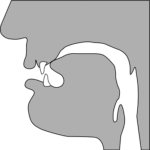The sound of 'th' as in that, this, the ([ð] in the international phonetic alphabet), is not found in many languages, and some learners find it difficult.
But if you've struggled with this sound, here's some good news: native speakers don't always pronounce it clearly, either – sometimes we leave it out completely!
And knowing when we don't pronounce it clearly will help you understand better when people speak quickly.
It has to do with this special combination: when one words ends in the sound 'n,' and the next word begins with 'th' as in that, this, the. You'll see this sequence all the time in phrases like "in the," "on this," "been there, done that," "when they," and so on.)
In quick, everyday speech, these will be pronounced without a clear 'th.'
In these clips you'll hear each example twice in isolation, and then in context:
Great question!
There's a small difference that most native speakers don't think about.

In North America, we normally pronounce 'n' before a vowel by putting the tip of the tongue against the gums above the front teeth. That's how we say it in the phrase "in a."

In the phrase "in the," we pronounce the 'n' by putting the tip of the tongue against the back of the front teeth. And then we often leave the 'th' out completely!
It's a subtle difference, and if you ask native speakers, they may not even be aware that they are doing this.
Try listening to the examples above again, then repeat, paying close attention to where you place your tongue.
Dictation
Now try practicing with some mini-dictations. Each contains some words with the sequence "n th," though you won't hear a clear 'th' sound. You'll hear each phrase three times.
Answer
Answer
In this example there are three instances of 'th,' but only two are pronounced clearly. Why?
Answer
This clip has two examples of "n th" pronounced as a single [n̪], pronounced with the tongue against the teeth.
Answer
